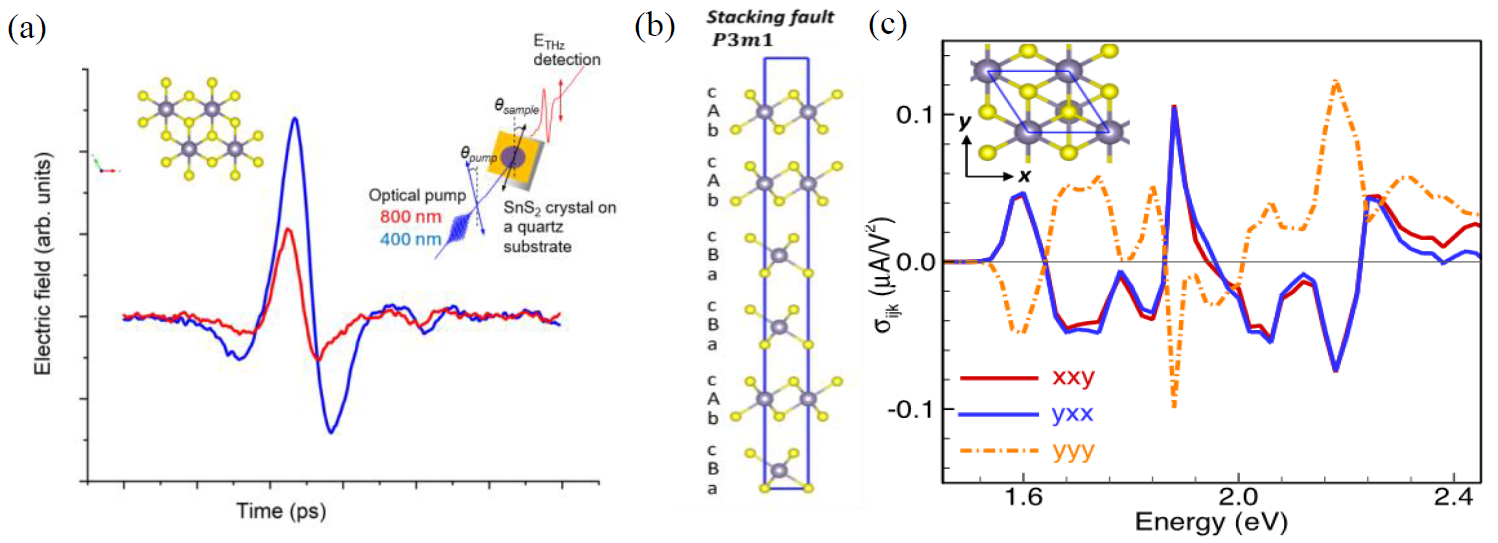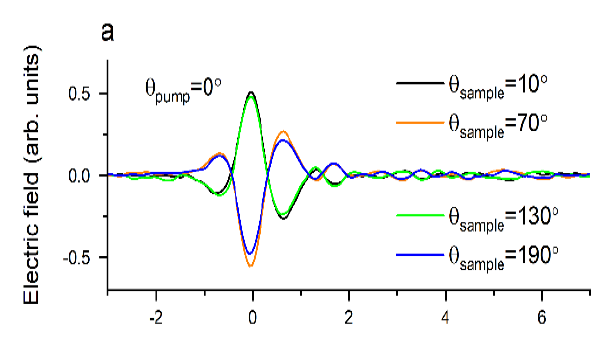| PREVIOUS PRESENTATION | BACK TO PROGRAM OVERVIEW | NEXT PRESENTATION |
Ultrafast shift current and optical rectification in SnS2 single crystals: the case for symmetry breaking due to the presence of stacking faults
Kateryna Kushnir Friedman1, Sepideh Khanmohammadi1, Erin M. Morissette1,*, Curtis W. Doiron2, Roy Stoflet2, Kristie J. Koski3, Ronald L. Grimm2, Ashwin Ramasubramamiam4,5 and Lyubov V. Titova1
1Department of Physics, Worcester Polytechnic Institute, Worcester, MA 01609
2Department of Chemistry and Biochemistry, Worcester Polytechnic Institute, Worcester, MA 01609
3Department of Chemistry, University of California, Davis, CA, 95616
4Department of Mechanical and Industrial Engineering, University of Massachusetts, Amherst, MA 01003
5Graduate Program in Materials Science and Engineering, University of Massachusetts, Amherst, MA 01003
*Currently at Department of Physics, Brown University, Providence, RI 02912
Single-crystal tin disulfide (SnS2) is a van der Waals 2D layered semiconductor with the band gap of ~2.3 eV, high carrier mobility on the order of ~ 800 cm2/V s [1], and good environmental stability. It is a promising material for applications in electrochemical sensors, photodetectors, photovoltaics, electrocatalysis, and electrochemical energy storage, as well as in solar energy conversion applications. We have investigated 2nd order optical nonlinear properties of single crystalline SnS2 that give rise to emission of THz pulses in response to below- and above-gap optical excitation at normal incidence, as shown in Fig. 1(a).

Figure 1. (a) Emitted THz pulses from single crystal SnS2 upon photoexcitation with 400 or 800 nm. Insert shows structure of the single crystal and geometry of the experiment. (b) Structural model of stacking faults with P3m1 symmetry. (Sn: grey spheres; S: yellow spheres), (c) Shift-current tensor components for 4H SnS2 (space group 156; P3m1) calculated using density functional theory. A top view of the basal plane and the choice of Cartesian axes is indicated in the inset. Only those tensor components that contribute to the in-plane shift current (Jx, Jy) are displayed here.
The SnS2 multilayers can exist in different polytypes, characterized by distinct stacking sequences [2]. The most common polytypes are 2H and 4H in the Ramsdell notation. The former is characterized by P3m1 space group which preserves inversion symmetry of the monolayer and thus cannot exhibit 2nd order nonlinearities. The latter is non-centrosymmetric and characterized by the P63mc space group. However, its symmetry allows only out-of-plane responses that are not detectable at the normal incidence. We have carried out THz emission spectroscopy measurements on the 2H SnS2 single crystal and observed emission of THz emission by both optical rectification excited by below band gap (800 nm; 1.55 eV) pulses as well as by the shift current, excited by above gap (400 nm; 3.1 eV) pulses. As expected, the shift current is a much stronger effect compared to the rectification current [3]. We argue that the underlying symmetry breaking arises due to the presence of stacking faults that are known to be ubiquitous in SnS2 as well as other transition-metal dichalcogenides single crystals. We present a possible structural model of a stacking fault with symmetry properties consistent with our experimental observations. Structural model of stacking faults is shown in Fig. 1(b).
Multilayer SnS2 crystals (1-10 mm wide and several micrometers thick) for this study were grown using two-zone chemical vapor transport. X-ray diffraction (XRD) and X-ray photoelectron spectroscopy (XPS) were used to confirm the synthesis of phase-pure SnS2. Additionally, single crystal diffraction identified the crystals as the 2H phase (space group P3m1). Peak broadening was noticed, beyond instrumental linewidth broadening, in the powder XRD which is consistent with defects such as stacking faults [4,5]. Brillouin scattering spectra were performed to show spectral rotation symmetry which is consistent with a hexagonal phase of SnS2 and identify a set of strong peaks that likely originate from the significant reflections resulting from defects and stacking faults, thus confirming the presence of the stacking fault disorder.
We have investigated 2nd order nonlinear properties of SnS2 using THz emission spectroscopy (TES) and first principles density functional theory (DFT). We find that photoexcitation with above band gap (400 nm, 3.1 eV) and belove band gap (800 nm, 1.55 eV) results in THz emission, as shown in the Fig. 1, despite being forbidden by the centrosymmetry of the phase of this crystal, which is 2H SnS2, P3m1. In a non-centrosymmetric material above bandgap photoexcitation can lead to the generation of ultrafast photocurrents such as shift current. Shift current is spatial shift of the center of charge during excitation [2]. The bandwidth of the observed emission extends to ~3 THz, which is independent of the excitation fluence and is limited by the bandwidth of the 1 mm thick ZnTe detector crystal. We attribute below bandgap photoexcitation to optical rectification in SnS2 and above bandgap to the shift current. For this we have investigated the symmetry and excitation fluence-dependent properties of THz generation. The emitted THz pulses reverses polarity every 60° as shown in Fig. 2 for both 400 nm and 800 nm. As a result, the waveform shape, including polarity, is fully reproduced every 120°. We also find that the emission depends on the linear polarization of the excitation. We find that the polarity of emission changes when the polarization of the excitation is rotated by 90°. DFT calculations of the three tensor components, 𝜎xxy, 𝜎yxx and 𝜎yyy as a function of excitation energy for the P3m1 phase stacking-fault model show that tensor components satisfy the expected relation 𝜎xxy> = 𝜎yxx = −𝜎yyy, Fig. 1 (c). These results are qualitatively consistent with the underlying spacegroup symmetries of the stacking-fault model.

Figure 2. Dependence of THz emission from SnS2 crystal following optical excitation with 400 nm, 220 μJ/cm2 pulses, linearly polarized along THz detection direction (𝜃pump = 0°), on sample.
We have shown that the symmetry properties of this emission are consistent with that of a P3m1 phase, and the underlying symmetry breaking arises due to the presence of stacking faults that are known to be common in SnS2 single crystals. These results suggest that SnS2 is a promising source material for THz photonics. This work also highlights the application of THz emission spectroscopy as a sensitive tool for investigating electronic properties, ultrafast photocurrents as well as the symmetry properties of materials.
References
[1] Binod Giri, Maryam Masroor, Tao Yan, Kateryna Kushnir, Alexander D. Carl, Curtis Doiron, Haochuan Zhang, Yanyan Zhao, Arthur McClelland, Geoffrey A. Tompsett, Dunwei Wang, Ronald L. Grimm, Lyubov V. Titova, and Pratap M. Rao. Balancing light absorption and charge transport in vertical SnS2 nanoflake photoanodes with stepped layers and large intrinsic mobility. 9(31):1901236, 2019. 127
[2] Whitehouse, C. R.; Balchin, A. A. Polytypism in tin disulphide. Journal of Crystal Growth 1979, 47(2), 203-212. DOI: https://doi.org/10.1016/0022-0248(79)90243-4
[3] JE Sipe and AI Shkrebtii. Second-order optical response in semiconductors. Physical Review B, 61(8):5337, 2000. 10, 44, 48
[4] Pujar, V. V.; Cawley, J. D. Effect of Stacking Faults on the X-ray Diffraction Profiles of β-SiC Powders. Journal of the American Ceramic Society 1995, 78(3), 774-782. DOI: https://doi.org/10.1111/j.1151-2916.1995.tb08246.x
[5] Pandey, D.; Krishna, P. X-ray diffraction study of stacking faults in a single crystal of 2H SiC. Journal of Physics D: Applied Physics 1977, 10(15), 2057. DOI: 10.1088/0022-3727/10/15/009
